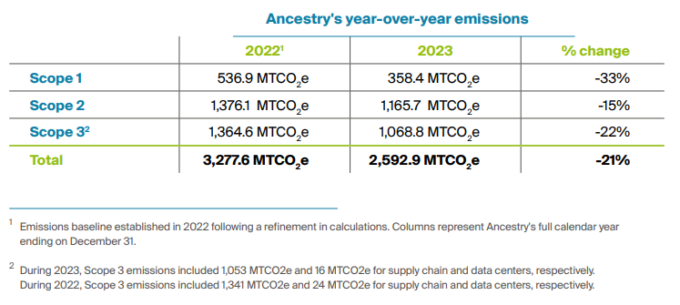 Today is Earth Day. I wondered how genealogical organizations are doing.
Today is Earth Day. I wondered how genealogical organizations are doing.
Kudos to Ancestry, which last month published its 2023 Impact Report. It’s the third in an annual series documenting its progress toward “building a more connected, resilient and sustainable future for generations to come,” and organized into three main sections: ethical business practices, diversity, equity & inclusion, and community impact.
Here, I’ll focus on carbon emissions, which are reported to be reduced by 21% in 2023. That follows an emissions cut of 32.9% year-over-year in 2022.
The report includes the following table:
 Scope 1 covers emissions from sources that an organisation owns or controls directly – for example from burning fuel in its fleet of vehicles (if they’re not electrically-powered).
Scope 1 covers emissions from sources that an organisation owns or controls directly – for example from burning fuel in its fleet of vehicles (if they’re not electrically-powered).
Scope 2 are emissions that a company causes indirectly and come from where the energy it purchases and uses is produced. For example, the emissions caused when generating the electricity used in their buildings.
Scope 3 encompasses emissions that are not produced by the company itself and are not the result of activities from assets owned or controlled by them, but by those that it’s indirectly responsible for up and down its value chain. An example of this is purchase, use and dispose of products from suppliers. Scope 3 includes all sources not within the scope 1 and 2 boundaries.
For perspective, the 2023 total is the equivalent of 6,401,336
miles driven by an average gasoline-powered passenger vehicle. For an Earth Day perspective, that’s 257 times around the earth at the equator.
Some of Ancestry’s specific reductions:
“In Dublin, we moved to a new office space with a green lease in a LEED Platinum-rated building that reduced our footprint by more than 50%.”
On June 1, 2023, Ancestry added a new fulfillment center for the Eastern U.S. in Nashville, Tennessee lowering carbon emissions from U.S. shipping by more than 25%.
Those follow reductions achieved in 2022 by closure of Ancestry’s Salt Lake City office and the transition to
100% renewable energy by Scope 3 data center provider AWS.
These major reductions likely represent the low hanging fruit. A minimum 5% reduction in emissions annually is anticipated for the future.
It’s not clear whether these figures are based on independant audits and how Ancestry compares to its peer group.


At least they’re trying…and being transparent.
I see it as green in that I don’t have to fly across the pond each time I need to look at a record (not that I could afford to do so anyway)…